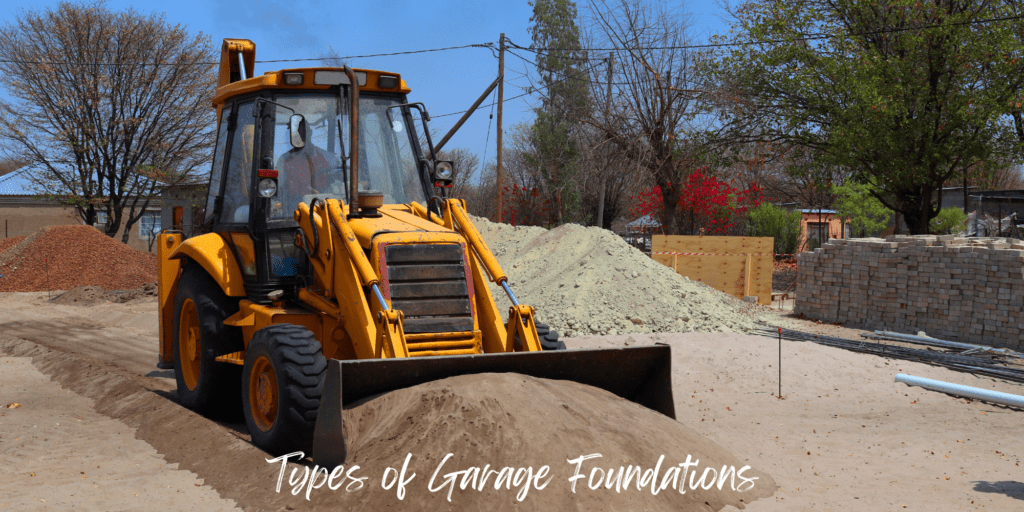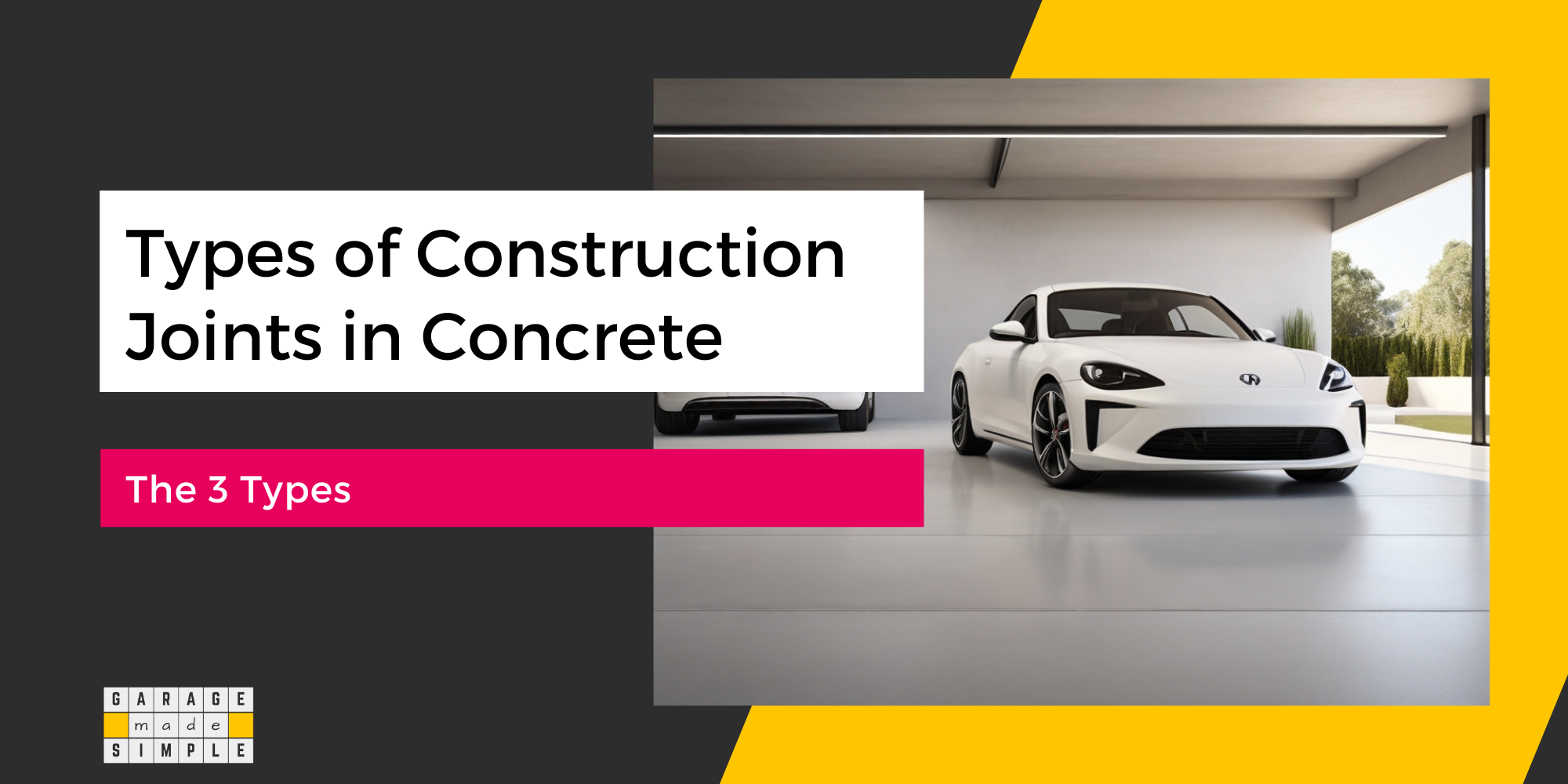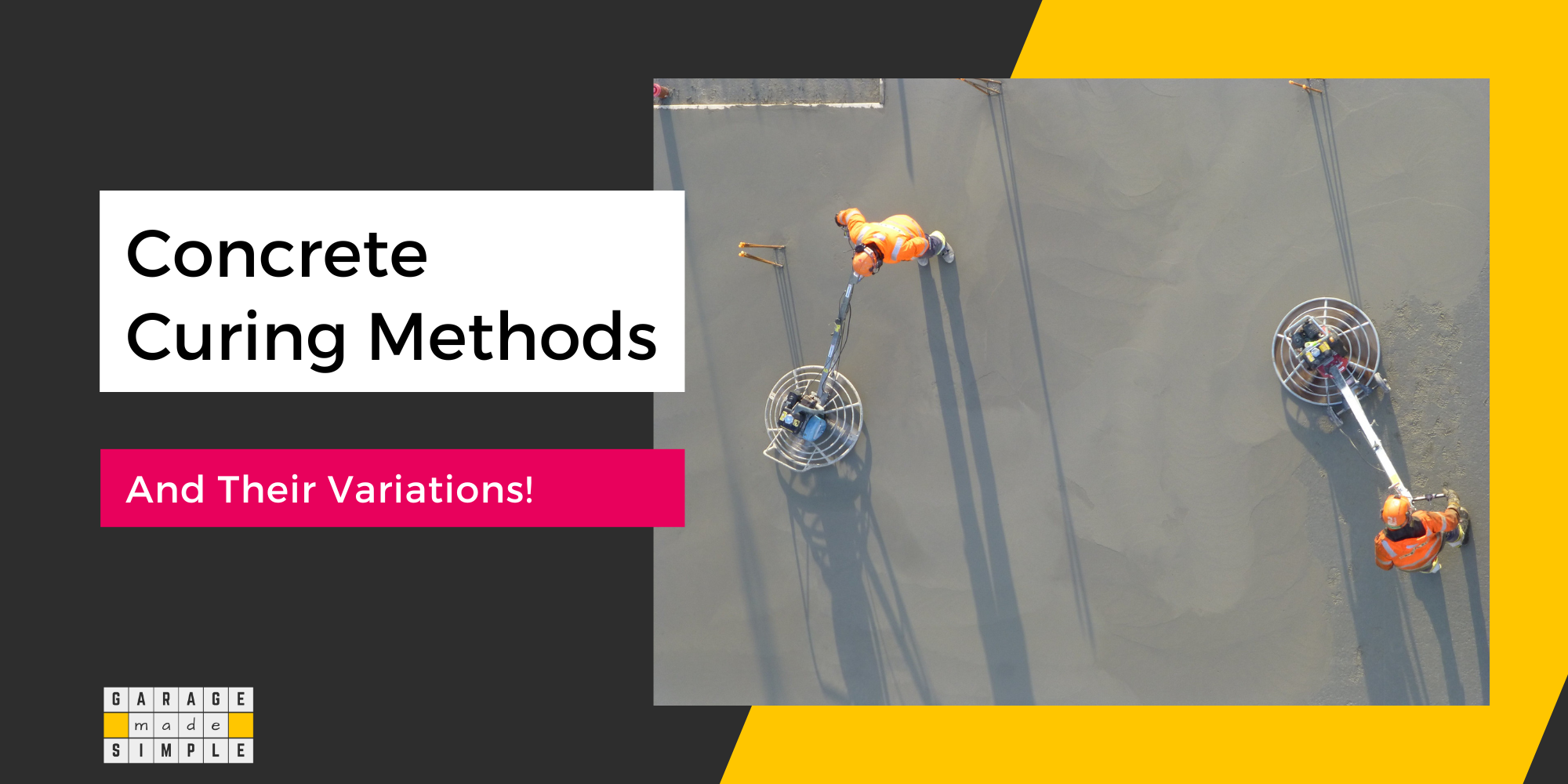8 Types of Garage Foundations: Which is Best For You?
As an Amazon Associate, I earn from qualifying purchases.
When you look at a detached garage, the roof, walls, and garage door catch your immediate attention. However, this entire superstructure sits on a slab, foundation, and possibly footings.
There are 8 types of garage foundations, but whatever the type, its ultimate objective is to provide stable support to the garage superstructure and transfer both dead and live loads uniformly to the grade below.

What is a Garage Foundation?
A garage foundation is the base that holds the structure in place, distributing its weight evenly into the ground. Most garage foundations start with footings, which spread the load and help stabilize the building.
Proper footings are especially crucial in cold climates, where they are placed below the frost line to prevent frost heave (the shifting of soil due to freezing and thawing).
Why the Right Foundation Matters?
The right foundation ensures your garage stays level and dry, even in varying soil or weather conditions. A poor choice of garage foundation can lead to issues like uneven floors, water infiltration, or shifting walls.
Climate, soil type, and the size of the garage, all play a role in foundation selection. For instance, gravel foundations may work for small, temporary garages but won’t offer the durability of a poured concrete slab.
Meanwhile, options like frost-protected shallow foundations (FPSF) help prevent structural damage in colder regions.
Types of Garage Foundations at a Glance
There are eight types of garage foundations, each with unique advantages and limitations. In this article, we’ll explore the following options:
- Poured Concrete Slab
- T-Shaped Foundation
- Pier and Beam Foundation
- Pile (Raised) Foundation
- Frost-Protected Shallow Foundation (FPSF)
- Concrete Masonry Units (CMU) Foundation
- Gravel Foundation
- Wood Foundation
Choosing the right foundation ensures your garage can handle the demands of your location and usage.

Factors to Consider When Choosing a Foundation
Choosing the right garage foundation requires evaluating several important factors. Each site and project presents unique challenges, from soil conditions to climate.
Making the right choice upfront will ensure a durable garage structure that can weather the years in style. Below are the key considerations.
1. Climate & Frost Line Depth
The soil expands and contracts due to freezing and thawing cycles (frost heave). The freeze-thaw cycle is a common condition, in cold zones, like the northern states of the US and Canada.
Foundations like frost-protected shallow foundations (FPSF) or T-shaped foundations are ideal for regions where the frost line runs deep.
On the other hand, simpler options such as poured concrete slabs are often sufficient in temperate coastal and southern states of the US, where the climate is milder.
2. Soil Composition & Topography
Some soils, such as clay, expand significantly when wet, causing foundations to shift. In these conditions, pier and beam or pile foundations provide more stability as they are anchored deep into the ground.
If the site is sloped, raised foundations are desirable and work better than slabs, to level the structure.
3. Garage Size & Usage Plans
The weight and purpose of the garage dictate the strength of the foundation. A larger, multi-bay garage requires stronger foundations like poured concrete slabs or CMU block foundations.
However, lightweight garages or sheds may sit comfortably on gravel foundations or wood platforms.
4. Installation Time & Cost-Effectiveness
Homeowners looking for faster installation might prefer gravel or wood foundations. Of course, they have their limitations.
Solutions like concrete slabs or CMU foundations provide greater long-term value. But, they have higher upfront costs and longer installation times.
5. Durability & Maintenance Needs
Foundations made from concrete or CMU blocks offer excellent durability with minimal upkeep.
Wood foundations require more frequent inspections to prevent moisture damage and rot. Gravel foundations may need regular maintenance to compensate for shifting.

Types of Garage Foundations Explained
Choosing the right foundation is critical for the stability and durability of any structure, even your garage. Below are the eight most common types of garage foundations, with their key advantages, disadvantages, and ideal use cases.
1. Poured Concrete Slab Foundation
A poured concrete slab foundation is also known as a slab-on-grade foundation. A poured concrete slab is one of the most popular foundation choices for garages due to its simplicity, durability, and relatively low cost.
This type of foundation involves pouring a thick, reinforced concrete slab directly onto compacted soil. It often includes a slightly thicker perimeter to serve as both the footing and the base, known as a thickened slab foundation.
Advantages:
- Durability: Concrete slabs are long-lasting and require minimal maintenance.
- Ease of installation: Suitable for most flat lots and can be completed quickly.
- Cost-effective: Offers a good balance between affordability and strength for standard garages.
- Minimal maintenance: Slabs don’t require regular inspections or repairs.
Disadvantages:
- Susceptible to cracking: The concrete slab can develop structural cracks, unless reinforced properly, due to soil movement or seismic activity.
- Not ideal for slopes: Installing a slab foundation on uneven ground requires extensive site preparation, adding to the cost.
- Limited access to utilities: Once the slab is poured, it is impossible to access plumbing or electrical lines without cutting through the concrete.
When to Use:
A poured concrete slab works best for one- or two-car garages on level ground in mild climates where frost heave isn’t a concern. If additional strength is needed, reinforced slabs can be used to prevent cracking.
A slab-on-grade foundation can be a floating garage slab, which is suitable for smaller garages with very light loads. For medium size garages with moderate loads, a monolithic garage slab works better.
2. T-shaped Foundation
The T-shaped foundation provides enhanced structural support by using a combination of a footing and a vertical stem wall.
The footing, which extends below the frost line, provides stability and prevents frost heave, while the stem wall lifts the garage floor above ground level.
This type is commonly used for garages with basements or when heavy loads will be stored inside.
Advantages:
- Supports heavy structures: The combination of footings and walls ensures the foundation can bear significant weight.
- Ideal for cold climates: Since the footings extend below the frost line, it prevents the foundation from shifting during freezing and thawing cycles.
- Versatile: Works well on uneven or sloping ground with minimal site grading.
Disadvantages:
- More expensive: T-shaped foundations require more materials and labor compared to simpler slab foundations.
- Longer installation time: Multiple steps are involved, including pouring the footings, building the stem walls, and filling the interior space with concrete or gravel.
- Requires skilled labor: DIY installation is not recommended due to the complexity involved.
When to Use:
The T-shaped foundation is ideal for large garages, garages with basements, or those built in cold climates with a deep frost line.
It is also a good choice when the garage needs to support heavy loads like workshop equipment or multiple vehicles.
3. Pier and Beam Foundation
A pier and beam foundation uses a network of vertical piers anchored into the ground to support horizontal beams, which in turn carry the weight of the garage.
This design creates a crawl space underneath, allowing easy access to plumbing, electrical lines, or other utilities.
Pier and beam foundations are often used in areas with unstable or expansive soil, where a traditional slab foundation might crack over time.
Advantages:
- Ideal for unstable soil: The piers transfer the load to deeper, more stable ground, reducing the risk of shifting or cracking.
- Creates a crawl space: This allows for easy repairs and future installations of utilities without cutting into the floor.
- Elevation: The garage stays elevated, which can help prevent water damage in areas prone to flooding.
Disadvantages:
- Vulnerable to moisture and pests: The crawl space, if not properly sealed and ventilated can attract pests or accumulate moisture, leading to mold.
- Requires regular maintenance: Wood beams can deteriorate over time and need periodic inspections.
- Higher cost than slabs: While it offers more flexibility, it can be more expensive and labor-intensive to install.
When to Use:
Pier and beam foundations are well-suited for uneven terrain and expansive soils, such as clay. They’re also a good choice for garages located in areas with frequent flooding or where future access to utilities will be needed.
4. Pile (aka Raised) Foundation
A pile foundation supports the garage on long vertical posts (or piles) driven deep into the ground.
The piles transfer the structure’s weight to more stable soil layers below, making it a popular option in areas with poor surface soil or uneven topography.
This design also raises the garage above ground level, helping to protect it from flooding.
Advantages:
- Stable on weak soil: Piles reach deep into solid layers, providing excellent support even when the upper soil is soft or prone to shifting.
- Flood protection: By elevating the garage, the structure stays safe from water damage in coastal or flood-prone areas.
- Minimal site preparation: Pile foundations require less grading, making them suitable for sloped lots or rugged terrain.
Disadvantages:
- High installation cost: Driving piles deep into the ground requires heavy machinery and skilled labor, increasing overall costs.
- Time-consuming: The process of installing piles is more complex than other foundation types.
- Limited DIY potential: Due to the technical expertise required, this foundation type isn’t suitable for DIY projects.
When to Use:
A pile foundation is ideal for coastal areas, flood zones, or sloped sites where other foundation types may struggle to provide stability. It’s also a good fit for areas with poor surface soil that can’t support a slab or pier-based foundation.
5. Frost-Protected Shallow Foundation (FPSF)
A frost-protected shallow foundation (FPSF) uses foam insulation around the footings to keep the soil warm and prevent frost heave, making it a smart option for garages in cold climates.
This design eliminates the need for deep footings by insulating the ground around the foundation, saving both time and money during installation.
Advantages:
- Prevents frost damage: By controlling soil temperature, the foundation stays stable during freeze-thaw cycles.
- Cost-effective for cold climates: Requires less digging compared to traditional deep footings.
- Faster installation: Saves time by reducing excavation and labor requirements.
Disadvantages:
- Not suitable for all soils: Some types of soil, such as heavy clay, may still experience shifting despite insulation.
- Requires careful planning: Insulation must be installed precisely to be effective.
- Specialized materials needed: Foam boards and insulated concrete add to the material costs.
When to Use:
FPSFs are best for cold regions with shallow frost lines. They are especially useful when you need to build a heated garage or want to avoid the hassle of deep footing.
This foundation type is also suitable for homes or garages that must be built quickly but still require long-term durability in harsh winter climates.
6. Concrete Masonry Units (CMU) Foundation
A concrete masonry unit (CMU) foundation consists of stacked concrete blocks reinforced with mortar and steel. This type of foundation is known for its strength, fire resistance, and durability, making it a reliable choice for large or custom-built garages.
CMU blocks are often used to create raised foundations or stem walls, adding stability to garages on uneven ground.
Advantages:
- High durability: Resistant to fire, termites, and decay.
- Strong load-bearing capacity: Supports heavy vehicles and large structures with ease.
- Great for uneven terrain: CMU foundations can be adapted to various lot conditions, including sloped areas.
Disadvantages:
- Labor-intensive installation: Stacking and reinforcing blocks takes time and requires skilled labor.
- More expensive than slabs: The cost of materials and labor is higher than simpler slab foundations.
- Susceptible to water penetration: Without proper waterproofing, CMU foundations can absorb moisture, leading to cracks or mold.
When to Use:
CMU foundations are ideal for large garages, multi-bay structures, or garages located on uneven terrain.
This foundation type is often preferred when additional strength or height is required, such as for detached garages that double as workshops or storage spaces.
7. Gravel Foundation
A gravel foundation is one of the simplest and most affordable options. It consists of compacted gravel spread evenly across the site to create a stable, level surface.
This type of foundation is often used for smaller or temporary garages since it provides good drainage but limited structural support.
Gravel foundations are particularly appealing to DIYers because they require minimal tools and expertise to install.
Advantages:
- Affordable: Gravel is inexpensive and widely available, making this option very cost-effective.
- Quick and easy installation: This foundation can often be completed in a day with basic tools.
- Excellent drainage: Gravel prevents water from pooling under the structure, reducing the risk of water damage.
Disadvantages:
- Limited structural support: Not suitable for heavy or permanent garages.
- Requires maintenance: Gravel can shift or settle over time, needing periodic leveling.
- Not suitable for slopes: Uneven ground requires significant preparation to ensure stability.
When to Use:
Gravel foundations are best for small, lightweight garages or temporary carports. They also work well in dry climates where drainage is a concern but heavy foundations aren’t required.
This foundation type is ideal for homeowners looking for a budget-friendly, DIY solution that can be completed quickly.
8. Wood Foundation
A wood foundation consists of treated wood beams or planks placed directly on the ground or a gravel base. This type of foundation is lightweight and easy to install, making it a popular choice among DIY enthusiasts.
However, wood requires proper treatment and maintenance to resist moisture, insects, and rot.
Advantages:
- DIY-friendly: Wood foundations are easier to install than concrete-based ones, making them suitable for self-build projects.
- Lightweight: Ideal for areas with soil that cannot support heavy foundations.
- Quick installation: Wood foundations can be installed in less time than concrete slabs or block foundations.
Disadvantages:
- Vulnerable to moisture and pests: Even treated wood needs regular inspections to prevent rot and insect damage.
- Shorter lifespan: Wood foundations require more maintenance and don’t last as long as concrete alternatives.
- Limited weight support: They are not suitable for large or heavy garages.
When to Use:
Wood foundations are ideal for temporary garages, sheds, or small DIY projects where speed and affordability are priorities.
This foundation type works best in dry climates where moisture won’t compromise the wood’s integrity.
Pros & Cons: Summary of Garage Foundation Types
| Foundation Type | Advantages | Disadvantages | Best Use Cases |
|---|---|---|---|
| Poured Concrete Slab | Durable and low maintenance Cost-effective Easy to install |
Prone to cracking on unstable soil Not ideal for sloped lots |
One- or two-car garages in mild climates |
| T-Shaped Foundation | Supports heavy loads Works on uneven ground Prevents frost heave |
Higher cost Longer installation time |
Large garages or garages with basements in cold climates |
| Pier and Beam Foundation | Ideal for unstable soil Allows access to utilities (crawl space) Elevated to prevent water damage |
Prone to moisture and pests Requires regular maintenance |
Garages on expansive soil or flood-prone areas |
| Pile (Raised) Foundation | Excellent stability on weak soil Minimal site prep Good flood protection |
Expensive Requires professional installation |
Coastal areas or sloped lots with poor surface soil |
| Frost-Protected Shallow Foundation (FPSF) | Prevents frost heave Cost-effective alternative to deep footings Faster installation |
Not suitable for all soils Requires precise insulation |
Heated garages in cold regions with shallow frost lines |
| Concrete Masonry Units (CMU) Foundation | Strong load-bearing capacity Resistant to fire and termites Works on uneven terrain |
Labor-intensive Susceptible to moisture without waterproofing |
Large, multi-bay garages or workshops |
| Gravel Foundation | Affordable and quick to install Excellent drainage |
Limited structural support Requires frequent leveling |
Temporary or lightweight garages in dry climates |
| Wood Foundation | DIY-friendly Lightweight and fast to install Ideal for self-build projects |
Prone to moisture and insect damage Shorter lifespan |
Small, temporary garages or sheds in dry climates |
Frequently Asked Questions (FAQ)
1. What is the most durable type of garage foundation?
A poured concrete slab is one of the most durable and low-maintenance foundation options. It resists wear and tear, making it ideal for standard garages.
A CMU foundation provides additional strength and longevity, in case you need it.
2. Which garage foundation is best for DIY installation?
If you’re looking for a DIY-friendly foundation, gravel, or wood foundations are your best options.
Both are relatively easy to install with basic tools, making them ideal for homeowners with minimal experience. However, they are only suitable for lightweight garages or temporary carports.
3. How deep should a garage foundation be?
The depth of the foundation depends on the frost line in your region.
In cold climates, footings should be installed below the frost line (which can vary between 12 to 48 inches).
A 4 to 6-inch concrete slab or compacted gravel base is usually sufficient in regions without frost issues.
4. Can I use a gravel foundation for a permanent garage?
Gravel foundations are best suited for temporary or lightweight structures. A concrete slab or CMU foundation will provide better stability and longevity.
Bottom Line
Choosing the right garage foundation will ensure its durability, stability, and long-term performance. There are 8 types of garage foundations to choose from.
Your decision should consider key factors such as climate, soil composition, garage size, and intended use.
Options range from poured concrete slabs to gravel foundations. Each type of garage foundation has unique advantages, as well as, limitations.
For example, a frost-protected shallow foundation (FPSF) is ideal for cold climates, while a wood foundation offers a quick, DIY-friendly option for smaller, temporary structures.
Thank you very much for reading the post. I do hope you found it informative and useful.






